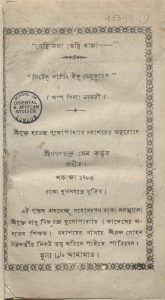Nineteenth Century Bengali Farces and the Comic Tradition
Priyanka Basu
A farce has often been deemed as a genre not complete in itself, but more in the form of appending a comic representation. Farces have been considered ‘lower’ in status to ‘high comedy’ primarily due to the excess of the comic body in performance and the inherent absurdities in dialogue. In 19th century Calcutta, farces—better known as prahasana—found a prolific expression both in print and on-stage. Proscenium stage performances of the prahasana included prominent farces like Buṛo Śālikera Ghāṛe Ron̐ (New Feathers on an Old Bird) and Ekei Ki Bale Sabhyatā (Is this what you call civilization?) by Michael Madhusudan Dutta (1824-1873), and those by Ramnarayan Tarkaratna (1822-1886) and Dinabandhu Mitra (1829-1873). A large number of these prahasana however, emerged as the ‘low-life print’ in Calcutta’s Bat-tala (literally, underneath the banyan tree), a space that was instrumental in propagating printing and publishing, mainly aimed at the non-elite and more marginal readership. These farces were subversive in nature, mostly written in the common Bengali parlance and presenting stock characters and commentaries on social vices. The play texts also contained songs from the contemporary popular traditions, thus linking print and performance together.
The SOAS Bengali collection within ‘Two Centuries of Indian Print’ includes three farces- Jemni Maja Temni Sājā by Gaganacandra Sena (1862, Dhaka New Press), Bau Haoẏā Eki Dāẏa by Guruprasanna Bandopādhyāẏa (1862, Gauṛīẏa Press), and Premadā Pramadā Nāṭaka by Guruprasanna Bandopādhyāẏa (1862, Prākṛta Press). In the preface to Jemni Maja Temni Sājā (which has a subtitle- ‘A Little Learning is Dangerous’) Gaganacandra Sena instructs the readers not to laugh at the title of the play and laugh only at the manners and caricatures of a ‘current community of people’. Similarly, in both Bau Haoẏā Eki Dāẏa and Premadā Pramadā Nāṭaka, the playwright Guruprasanna Bandopādhyāẏa articulates how he writes on the plight of women in Bengal so that there is a drive towards improving their conditions. Farces carried strong social messages intended to educate the readers about the ‘new vices’ of slowly urbanising Calcutta caught between a traditional past and a modern present.

cover page of one of the books
